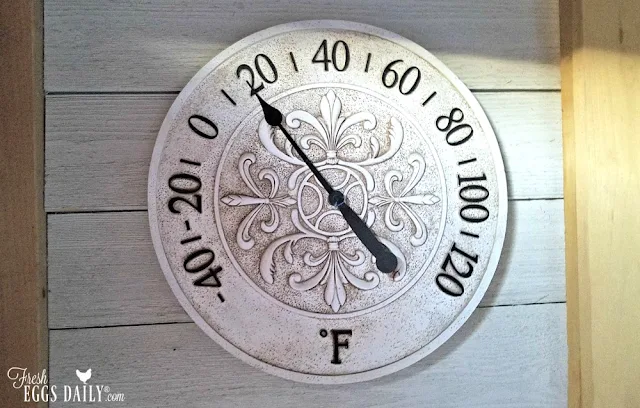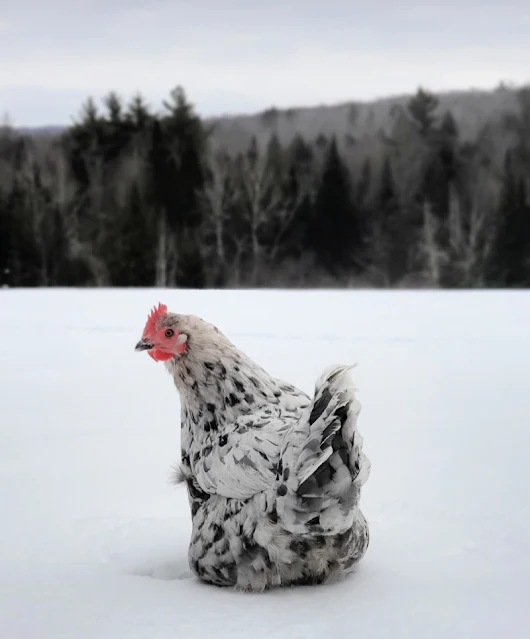How to Care for Chickens in Winter
We're heading into a several days long cold snap here in Maine this week.
Fortunately, our chickens have been able to slowly grow accustomed to the progressively colder winter weather over the past few weeks and all have a nice new set of feathers after a successful molt, so they can fluff them up to help stay warm.
How to Care for Chickens in Winter
Of course our coop is ready for winter with lots of straw on the floor and good ventilation to let any moisture and ammonia fumes escape, and our and run is winterized with clear tarps wrapped around the sides to serve as a wind block and create a bit of a greenhouse effect.
But frigid cold below zero degrees Fahrenheit means a little bit more TLC for our flock.
As long as they stay dry (a wet chicken loses the ability to fluff their feathers to stay warm), and can get out of the wind and elements, chickens do just fine in temperatures well below freezing, but when it starts to dip below 0, I admit I start to worry a bit.
Heating my coop is not an option for me for several reasons, not the least being the fire danger, but I don't believe that heat is necessary to keep my flock comfortable even in extremely cold weather.
Warm Straw Bedding in Winter
In addition to a nice thick layer of straw on the floor of the coop, when a cold snap approaches, I stack bales of straw along the coop walls.
The straw bales work wonderfully to insulate the coop and retain any warmth created inside by the chickens' own body heat and the sunlight that streams in through the windows on sunny days.
They work to take up lots of the dead (cold) air space in the coop. My coop generally stays between 10-20 degrees warmer than the outside temperatures.
I have noticed that on super cold days, my chickens will burrow down into the straw on the floor of the coop to stay warm also.
If you live in a northern climate and are using sand in your coop - please, please stop! For the sake of your chickens (and most certainly if you raise ducks), please switch to straw, at least for the winter.
There's no bedding that will keep your flock warmer.
Before I stacked the straw bales inside the coop, I cleaned out some of the soiled straw bedding and raked it out into the run over the snow and ice to give the chickens and ducks a spot to stand and eat so their feet won't get cold.

Ducks in Winter

Ducks are incredibly cold-hardy and will generally spend at least the warmest part of any given day outside, as long as they can get out of the wind. The same rules for staying dry don't apply to ducks, since their feathers are waterproof and cover a layer of insulating down. Plus they have a thicker layer of fat to keep them warm.
Since I had shoveled snow banks against the run fencing, our ducks were content to sit outside in their sunny little wind block! My ducks will often hop into a tub of water on a sunny day to take a quick bath, even in the middle of the winter!
Warm Treats and Water for Chickens in Winter
I love to make oatmeal for my chickens on cold mornings and of course they get a nice treat of scratch grains before bedtime in the winter.
But when it's extremely cold, I also like to pour some warm water over their layer feed to make a nice warm "porridge" for them.
I use heated dog water bowls - one for their water and one for their moistened feed - so nothing freezes.
Provide Fresh Air and Sunshine for Chickens in Winter
I do open the small door from the coop out into the run every day year round.
I give our chickens and ducks the option to go outside if they wish, and I leave their feed and water outside to deter rodents from wanting to take up residence inside the coop and to keep the coop clean and dry, so my chickens and ducks have to come outside to eat, at the very least.
But on frigid days, they do often choose to spend their time inside the coop. I sometimes will toss some sunflower seeds or unsalted peanuts into the run to give them something to do to keep from getting bored and to entice them outside.
Provide Good Coop Ventilation for Chickens in Winter
And in addition to the flannel curtains I hung over the coop windows that I close at night to keep the coop warmer, I also have drapes over the small pop door to prevent drafts from coming into the coop during the day.
Even in the winter, your coop needs good ventilation. Having vents or windows up high is best, you want upper air flow to let moisture and ammonia fumes escape, but no drafts down low.
Watch for Frostbite in Winter
I keep a tin of my homemade frostbite salve on hand to smear on those chickens with the larger combs on frosty nights, and frequently check combs and toes for signs of frostbite. (Keep in mind that older hens may be more susceptible due to poor circulation.)
I have a dog crate ready in case I need to bring an older hen indoors, and make sure I keep an extra supply of scratch grains and spare bales of straw on hand all through the winter because you never know when a nor'easter or ice storm will blow your way when you live in Maine, making a trip to the feed store impossible.
Love my coop thermometer in the top photo? Get yours here!
































